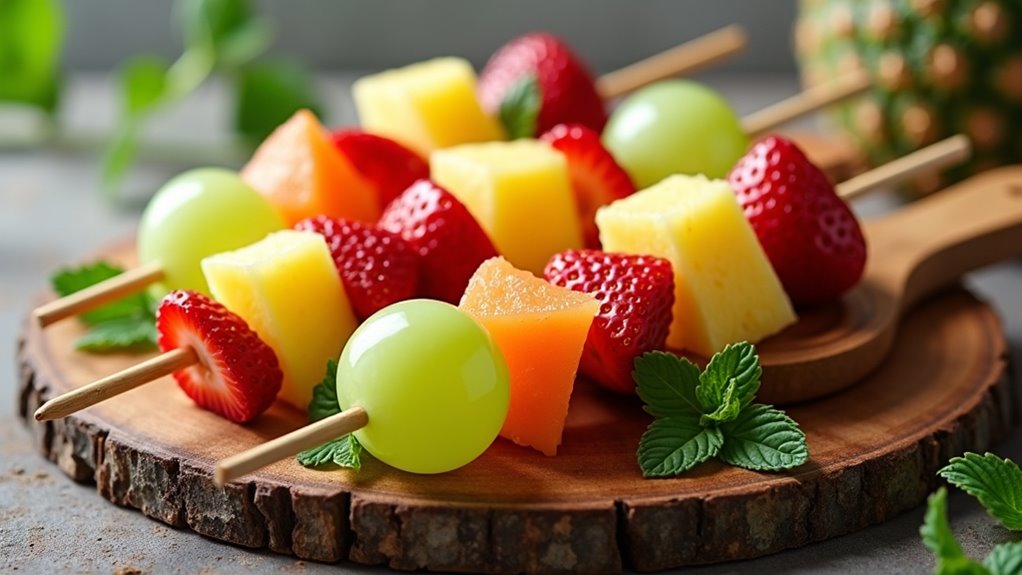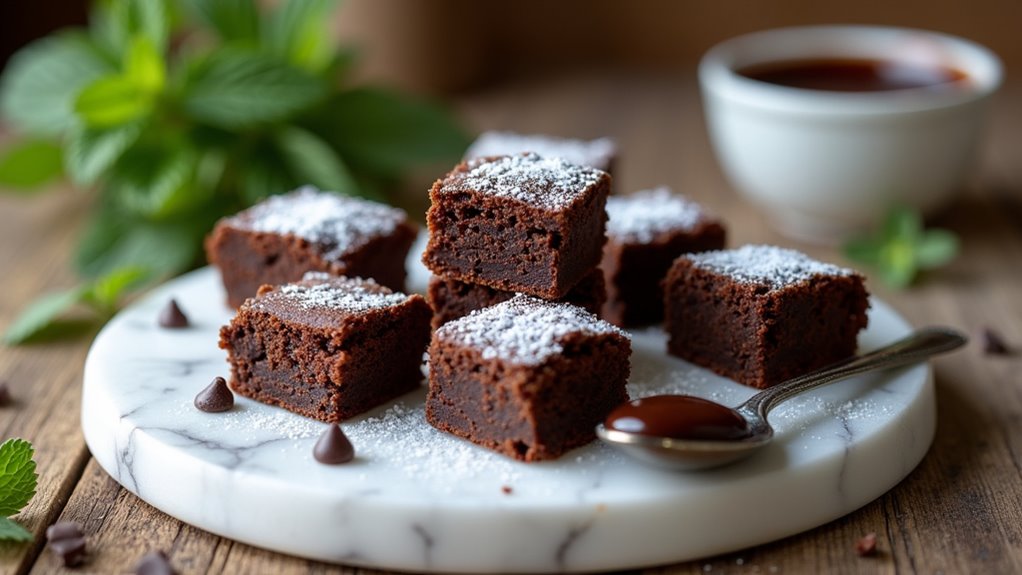My colleague Jenna burst into the kitchen, frantic about her upcoming garden party. “The dessert I planned fell through,” she sighed. As head chef at Riverside Bistro, I’ve rescued fancier affairs with simpler solutions. I grabbed some bamboo skewers and our freshest fruit. “Watch this,” I winked. Five minutes later, her eyes widened at the rainbow-bright arrangement. “Sometimes the simplest things impress the most,” I told her. “These will disappear faster than your complicated tart would have anyway.”
History & Origin
Because fruit skewers have a rich culinary history spanning multiple cultures, understanding their origins provides fascinating context for this popular dish.
Fruit kabobs emerged from ancient traditions of threading food onto sticks, evolving into a beloved healthy snack option. These colorful fruits became a staple at summer gatherings, offering a visually appealing presentation that’s easy to prepare.
Fresh fruit skewers reflect culinary trends emphasizing nutritious, attractive food choices. From picnics to barbecues, these simple yet versatile treats transformed how people enjoy fruit, combining practicality with delicious flavor in a convenient, portable format.
Recipe

Fruit skewers are a delightful and healthy snack that combines fresh, vibrant fruits in a fun and appealing way. Perfect for summer gatherings, children’s parties, or as a quick and nutritious treat, these colorful kabobs are both visually stunning and delicious.
Creating fruit skewers is an excellent opportunity to experiment with different fruit combinations and engage children in a hands-on cooking experience. By selecting a variety of seasonal fruits, you can create a rainbow of flavors and textures that will delight both kids and adults alike.
Ingredients
- 2 cups strawberries
- 1 cup pineapple chunks
- 1 cup orange segments
- 1 cup kiwi slices
- 1 cup blueberries
- Optional: Melted chocolate for drizzling
- Optional: Yogurt dip
Equipment
- Wooden or bamboo skewers
- Cutting board
- Sharp knife
- Mixing bowl
- Optional: Chocolate melting bowl
- Optional: Whisk
Instructions
- Wash all fruits thoroughly
- Cut larger fruits into bite-sized chunks
- Remove stems from strawberries
- Thread fruits onto skewers in alternating colors
- Arrange fruits tightly but not overcrowded
- Optional: Drizzle with melted chocolate
- Optional: Serve with yogurt dip
Nutrition
220 kcal | 55g Carbohydrates | 2g Protein | 1g Fat | 0.2g Saturated Fat | 0.3g Polyunsaturated Fat | 0.1g Monounsaturated Fat | 0mg Cholesterol | 5mg Sodium | 350mg Potassium | 500 IU Vitamin A | 85mg Vitamin C | 50mg Calcium | 1mg Iron
Cooking Tips
When preparing fruit skewers, select fruits that are ripe but firm to ensure the best texture and flavor. Consider the seasonality of fruits to maximize freshness and taste. For a more stable skewer, start and end with firmer fruits like pineapple or orange segments, using softer fruits like berries in the middle.
Serving Suggestions
Elevate your fruit skewers by presenting them on a stylish platter with complementary dips like honey-yogurt sauce or melted dark chocolate. Consider color coordination when selecting fruits, mixing vibrant options like strawberries, kiwi, and blueberries to create a visually stunning display.
For added sophistication, garnish the platter with fresh mint leaves or edible flowers. Serve chilled to maintain freshness, and arrange skewers in a fan or circular pattern to maximize visual appeal. When hosting brunch or children’s parties, place the skewers strategically near other light appetizers or desserts to encourage sampling.
Common Mistakes & Troubleshooting
One common mistake when preparing fruit skewers is cutting fruits too far in advance, which can lead to browning and loss of freshness. During a summer party I hosted, I initially prepared my skewers two hours before guests arrived and found the bananas had turned an unappetizing brown.
To prevent this, I recommend cutting fruits just before assembly and brushing delicate fruits like apples and bananas with a mixture of lemon juice and water to prevent oxidation. Additionally, ensure fruits are thoroughly dried after washing to prevent soggy skewers and maintain optimal texture.
Frequently Asked Questions
Can I Make Fruit Skewers the Night Before?
Yes, I can make fruit skewers the night before! I’ll prevent browning by soaking fruits in lemon-lime soda and store them covered in the refrigerator. I’ll aim to enjoy them within 24 hours for the best taste and freshness.
What Fruit Is Best on a Skewer?
I recommend strawberries, oranges, and pineapples as top skewer fruits. They’re colorful, sweet, and cut easily. Mix in kiwi, blackberries, or grapes for variety. Choose fresh, seasonal fruits that’ll look vibrant and taste delicious on your skewers.
Do I Need to Soak Skewers for Fruit?
I don’t need to soak skewers for fruit skewers since I’m not grilling them. However, soaking for 30 minutes can prevent splintering. I’ll just check the skewers for any rough edges before assembling my colorful fruit arrangement.
How to Cut Fruits for Skewers?
I’ll cut each fruit uniformly into bite-sized pieces. Strawberries get halved, oranges segmented, kiwi sliced into chunks, and larger fruits like pineapple cubed. This ensures even cooking and makes skewering easier and more visually appealing.
Final Thoughts
These colorful fruit skewers are more than just a snack—they’re a versatile option for any occasion. By mixing different fruits and getting creative with presentation, you’ll impress everyone while enjoying nutritious, fresh ingredients. Whether for a party or an after-school treat, these skewers offer a quick, fun way to enjoy vibrant flavors.
If you’re looking for a fresh and healthy party snack, pair your Fruit Skewers with a colorful Veggie Tray With Dip for a perfect balance of sweet and savory flavors!


